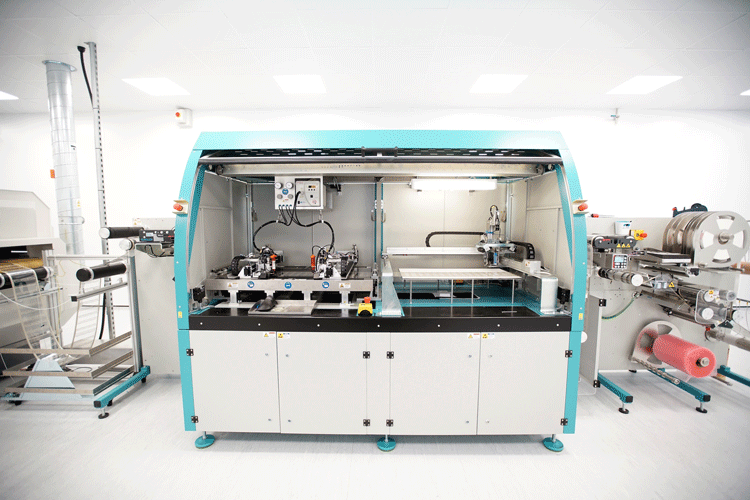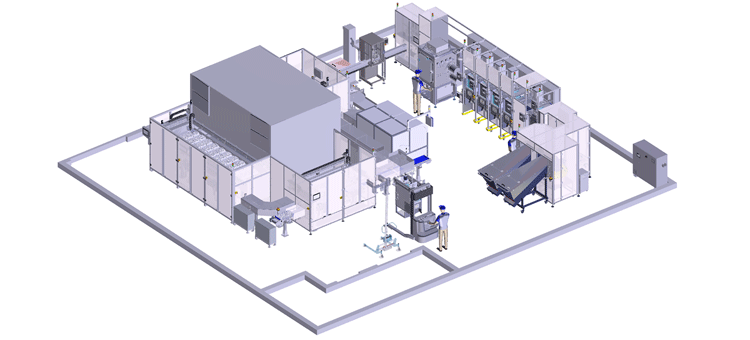The circuit of life: saving on manufacturing, waste and delivery-related supply chain inefficiencies
Posted: 26 June 2020 | Dr Alex Cole (CPI), Dr Dave Berry (CPI) | No comments yet
Many pharmaceutical companies have complicated supply chains that are inefficient and ill-equipped to deal with current demands. This article explores how digitalising the healthcare supply chain can address the pharmaceutical sector’s increasing financial-, capacity- and waste-related strains associated with our ageing population and the soaring costs of new treatments.


Strained supply chains
Manufacturing plants face a constant battle to match supply with demand, meaning drugs are often
over-produced to prevent potential stock-outs”
Digital innovations have dramatically impacted society, changing the way we interact with one another, making our homes smarter and causing fundamental changes in industries as diverse as agriculture and automobiles. However, the pharmaceutical and healthcare industries are still waiting to unlock the full potential of digitalisation. These sectors are under immense strain, caused by the interplay of many factors. The population is not only growing, but demographics are changing. In the UK, the proportion of people aged 65 and above has increased starkly over the last 20 years and is set to increase further still.1 An older population is inherently sicker than a younger population, with higher rates of chronic conditions such as diabetes, nervous system disorders and heart disease. Furthermore, the cost of drug development has soared,2 with the proportional return on investment falling as stratified and personalised therapies become a reality and the potential market for a new drug shrinks.
Inefficiencies throughout the current supply chain further contribute to the strain and costs faced by the pharmaceutical and healthcare sectors today. Manufacturing plants face a constant battle to match supply with demand, meaning drugs are often over-produced to prevent potential stock-outs. After leaving the plant there is further wastage due to transport losses and environmental spoil. Medicines must navigate the supply chain and the variety of environmental challenges it presents (-40ºC to +40ºC temperature ranges) while on the journey to the patients that need them. Finally, once the drug is with the patient there remains a substantial risk that it will not be administered correctly, if at all, negating its effectiveness.
Wastage can be reduced at every step of this chain by integrating digital tools that collect and share relevant data with manufacturers and healthcare professionals, as well as tools that can educate the patients themselves. The cost of carrying out clinical trials and the overall drug development process could be greatly cut by reducing waste and increasing patient adherence, allowing companies to reduce lead times and more quickly respond to fluctuating drug demand. In turn, this will help the pharmaceutical and healthcare sectors to stay on top of rapid demographic shifts.
Just-in-time clinical supply
Companies traditionally forecast demand for their drugs up to two years in advance of allocating space and resources in dedicated, large-scale manufacturing facilities. The long-term forecasting of drug demand (even when done well) is inherently flawed and does not provide the supply chain with the agility required to meet rapid fluctuations in demand. Furthermore, with the rise of personalised therapies, large-scale, single-purpose manufacturing facilities are becoming less practical to deliver the life cycle needs of the smaller, more tailored product runs that are required by the evolving market. Smaller-scale, digitally enabled plants that can manufacture multiple different drugs and deliver just-in-time manufacturing would greatly increase the flexibility and responsiveness of today’s supply chain, enhancing the usefulness of long-term forecasting. Crucially, these plants would cut the cost of clinical trials, allowing drugs to be manufactured and delivered when and where they are needed.


Technology at CPI’s National Printable Electronics Centre for producing smart packaging
At the Medicines Manufacturing Innovation Centre in Renfrewshire, Scotland, a consortium of industry and academia are working together in a bid to develop solutions that will benefit stakeholders across the entire pharmaceutical supply chain. The consortium includes two of the UK’s largest pharmaceutical companies, AstraZeneca and GSK, collaborating in this manner for the first time. One of the projects under development at the centre – the Pharmacy Automation for Clinical Efficiency (PACE) platform – is a digitally enabled, automated line for oral solid dose (OSD) production, packaging and labelling. The modular platform is designed to allow multiple drugs to be manufactured and packaged within the same facility without cross-contamination, which will mark a significant improvement over the setup of the current supply chain. Handling multiple drug substances within one modular platform will enable pharmaceutical companies to act more effectively when manufacturing tailored formulations or experiencing fluctuations in supply and demand. Once capsules are filled and packaged, bottles will be labelled and stored automatically by the PACE platform, cutting lead times on distribution to clinical study sites and individual patients.
Another aspect of manufacturing that can benefit greatly from digitalisation is the authorisation of drug distribution to individual clinical trial sites. Currently, this release authorisation is carried out by a Qualified Person (QP) who must collect and review the relevant data – often partially in paper form – in order to make decisions at a given site. As part of the PACE platform, all relevant GMP information will be collated automatically and presented to the QP in an easily digestible digital dashboard. This will allow certification decisions and subsequent drug distribution to occur more rapidly, driven by a QP who is potentially at another site. This will enable real-time release of clinical trial medicines in the first instance but will also lay down the mechanisms for digital QP certification of newly manufactured drugs, making a significant contribution to overall supply chain efficiency.


The Pharmacy Automation for Clinical Efficiency (PACE) platform
From plant to patient
Manufacturing is not the only aspect of the supply chain that suffers due to inefficiencies; wastage occurs throughout the entire journey of the drug, often due to environmental excursions. Many drugs are particularly sensitive to shock, temperature or humidity, and being exposed to the wrong conditions can deem them ineffective. When this occurs during a clinical trial it can have severe consequences for the clinical data obtained. Even when a safe and efficacious drug successfully reaches a patient, there is little guarantee that it will not be wasted. Global studies demonstrate that in patients undergoing long-term treatment, only 50 percent of medicines are taken as prescribed,3 leading to a loss of effectiveness and preventable poor patient outcomes. In addition, low adherence rates during clinical trials can affect the validity of obtained data. Digitally enabled ‘smart’ packaging, that takes advantage of recent advances in flexible and hybrid electronics,4 can be used to better monitor drugs throughout the supply chain, including while in shipment or with the patient. This smart packaging can support better decision-making during transport, resulting in more efficient supply chains and reduced losses from environmental excursions. When with the patient, digital adherence solutions facilitated through smart packaging can lead to more informed, supported and adherent patients, enabling better clinical trials.
Thin and flexible ‘smart tags’ can be fabricated by combining commercially available sensors with wireless communications such as Radio-Frequency Identification (RFID) and Near-Field Communication (NFC). These smart tags can be adhered to, wrapped around or embedded within pharmaceutical packaging, where they can be used to track and trace individual items and monitor environmental conditions. In addition, the tags can be connected to the cloud, enabling pharmaceutical or logistics companies to understand the conditions that medicines are subjected to throughout their journey from factory to patient. ReMediES – a consortium comprising big pharma, SMEs and other industry stakeholders – recently investigated the manufacture of smart tags with flexible hybrid electronics. The project once again demonstrated the importance of cross-sector collaboration and successfully developed smart packaging that could send environmental data directly to drug manufacturers via a mobile app. The tags were trialled within existing pharma supply chains and found to function reliably, providing relevant insights from factory gate to warehouse, across national borders. This digitalisation of the drug transport system will ensure that the medicines received by pharmacies and patients are both safe and effective.
The adoption of digitally enabled technologies will help to eliminate supply chain inefficiencies
and ultimately reduce costs”
Digitalisation of packaging can also be used to educate patients and, with their consent, to track and improve adherence to their treatment regimens. Embedding flexible electronics into bottle caps or blister packs can accurately monitor the time and date that tablets are removed. This not only grants clinicians, carers and potentially pharmaceutical companies a greater understanding about how drugs are used but can also send patients digital reminders to take their medication. Other digital packaging innovations include QR codes or NFC tags that hold administration instructions in different languages or via video and inhalers that can gauge whether the medication has been taken correctly. These types of digital solutions aim to ensure that medications are taken correctly when they reach the patient. This may represent the final step for reducing drug wastage in the supply chain, as well as unlocking potential routes to future outcome-based payment models. Essentially, digital solutions are key to reducing waste and improving patient health.
Manufacturing, monitoring, administering
Pharmaceutical and healthcare sectors across the globe are under pressure to respond to rising patient needs, while dealing with exorbitant costs and an inefficient supply chain. There are no quick fixes for these problems, but the adoption of digitally enabled technologies will help to eliminate supply chain inefficiencies and ultimately reduce costs. To understand the challenges in the current supply chain, and to develop the solutions needed to overcome them, there is a need for a collaborative approach that leverages the expertise and needs of diverse industry stakeholders. Projects such as ReMediES and the development of the PACE platform at the Medicines Manufacturing Innovation Centre demonstrate how SMEs, engineers and multinational pharmaceutical companies can come together to deliver digital innovations that will herald the pharmaceutical supply chain of the future. This supply chain will be one of high agility, high flexibility and reduced waste, ensuring that the healthcare sector can continue to care for all, in a rapidly expanding population.
About the authors




References
- Coates S, Tanna P, Scott-Allen E. Overview of the UK population – Office for National Statistics [Internet]. [cited 2020 Apr 27]. Available from: https://www.ons.gov.uk/peoplepopulationandcommunity…
- DiMasi JA, Grabowski HG, Hansen RW. Innovation in the pharmaceutical industry: New estimates of R&D costs. J Health Econ. 2016 May;47:20–33.
- Sabaté E, World Health Organization, editors. Adherence to long-term therapies: evidence for action. Geneva: World Health Organization; 2003. 198 p.
- https://www.uk-cpi.com/capabilities/flexible-hybridelectronics
Issue
Related topics
Drug Manufacturing, Drug Supply Chain, Informatics, Manufacturing, Production, Supply Chain
Related organisations
AstraZeneca, GlaxoSmithKline (GSK), Medicines Manufacturing Innovation Centre, ReMediES









